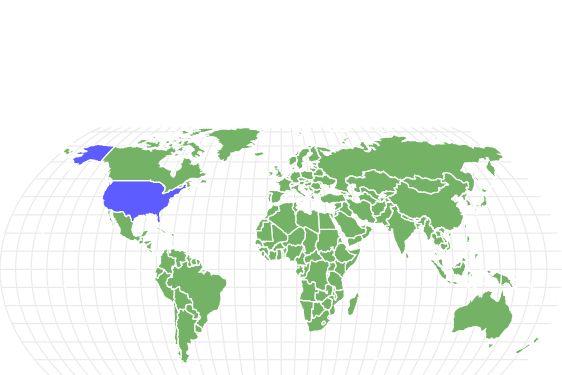Norwich Terrier
Canis lupus
Though Norwich terriers are small, they have a reputation for being feisty.
Advertisement
Norwich Terrier Facts
Norwich Terrier Physical Characteristics
Norwich Terrier as a Pet:
- General Health
- Energy Level
- Shedability
- Trainability
- Intelligence
- Tendency to Chew
- Size
- Family and kid friendliness
- Yappiness / Barking
- High
- Separation Anxiety
- Moderate
- Preferred Temperature
- Average climate
- Exercise Needs
- Moderate
- Friendly With Other Dogs
- High
- Pure bred cost to own
- $1500
- Dog group
- Terrier
- Male weight
- 11-12 lbs
- Female weight
- 11-12 lbs
This post may contain affiliate links to our partners like Chewy, Amazon, and others. Purchasing through these helps us further the A-Z Animals mission to educate about the world's species.
View all of the Norwich Terrier images!
Norwich Terriers are smart and fast making them a common sight at dog agility competitions.
A Norwich Terrier is a small dog with a big personality. They are smart, energetic, and sometimes stubborn. This breed originated in rural East Anglia, England in the late 19th century. They were bred to hunt down rodents in a home or barn and chase them out. This terrier was also used in packs to hunt foxes so they were bred to be more sociable than the standard terrier, which is generally very independent.
See all of our expert product reviews.
These canines are close relatives to the Norfolk Terrier and belong to the Terrier group. These spunky little dogs are very loyal to their owners. Socialized Norwich Terriers are a good choice for families with children.
Norwich Terrier Fun Fact
Norwich Terriers are smart and fast making them a common sight at dog agility competitions.
The 6 Different Types Of Norwich Terriers And Norwich Terrier Mixes
While there is only one specific breed of Norwich terrier, they do come in different types of hair/coats. They are red, black, tan, wheaten, and grizzled, where the black and red hairs are mixed. However, there are various mixed breeds that are combined with the Norwich Terrier. These different types of Norwich Terrier mixes include:
- Affenwich
- Nortese
- Cairnwich Terrier
- Pugwich
- Yorwich
- Norwich de Tulear
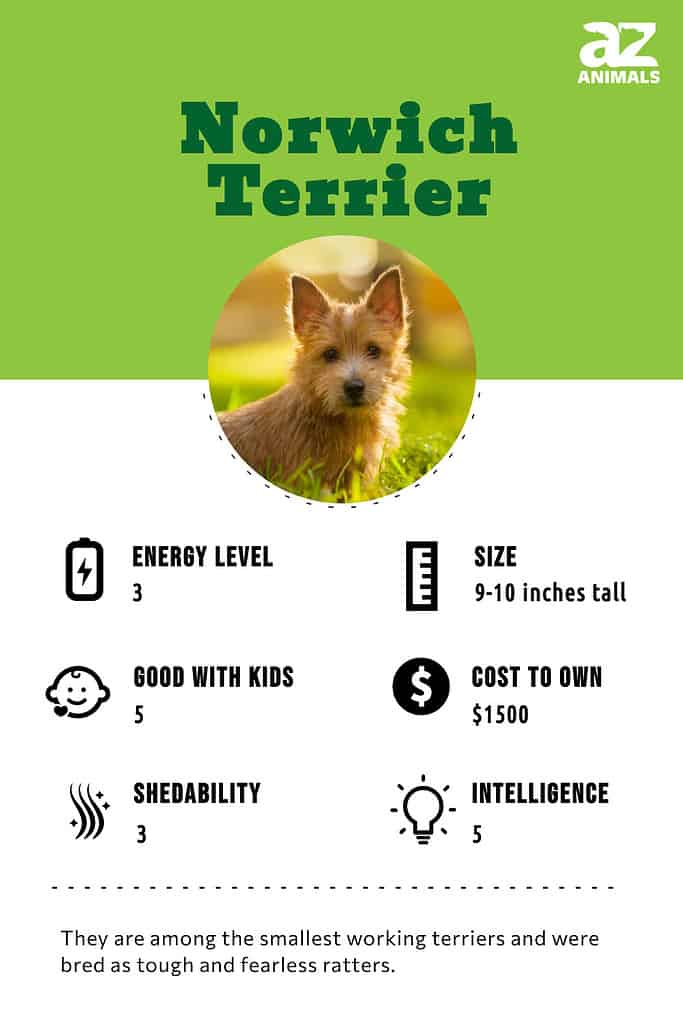
3 Pros And Cons Of Owning A Norwich Terrier
| Pros! | Cons! |
| A loyal pet: Norwich Terriers are loyal and protective of their owner. | Need lots of exercise: In order to burn off some of its abundant energy, this dog needs from 30 to 60 minutes of exercise each day. |
| A good watchdog: These dogs have a big voice and will let the household know when someone is at the door or on the property. | Extra grooming attention: In addition to weekly brushing, a Norwich Terrier’s double coat needs a grooming technique called hand-stripping to keep it looking healthy. |
| Good with children: Socialized Norwich Terriers interact well with the children in a family. | Digging: This dog loves to dig so an owner may find a collection of holes in the backyard. |
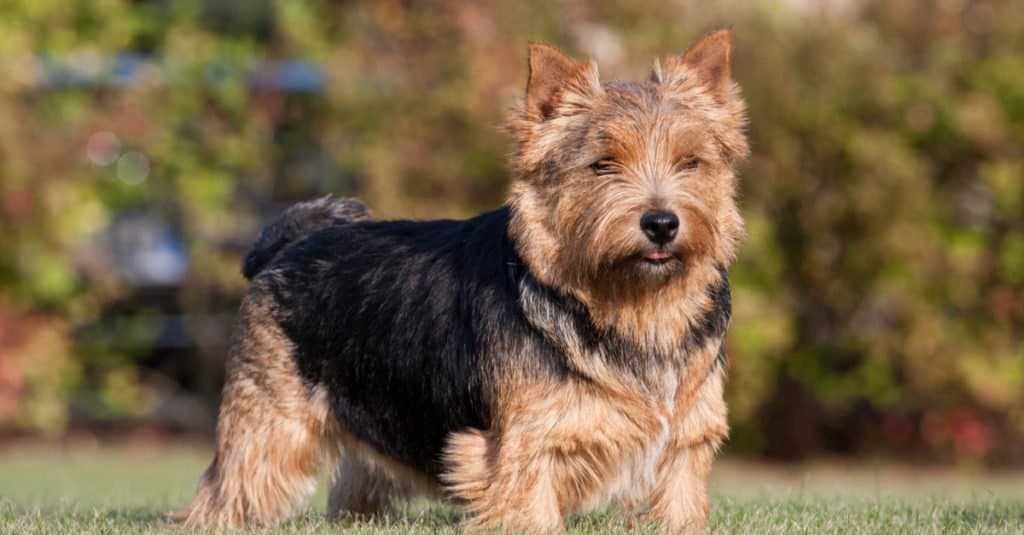
Norwich terriers have a big voice and will let the household know when someone is at the door or on the property.
©Lenkadan/Shutterstock.com
Health and Entertainment for your Norwich Terrier
See all of our expert product reviews.
Size And Weight
These dogs are small with a double coat. A male can grow to be 10 inches tall at the withers while a female can reach 9 inches tall. Males and females can weigh up to 12 pounds. At 9 weeks old, puppies weigh around 6 pounds and are considered fully grown at 8 months.
| Height (Male): | 10 inches tall |
| Height (Female): | 9 inches tall |
| Weight (Male): | 12 pounds, fully grown |
| Weight (Female): | 12 pounds, fully grown |
Norwich Terriers vs Norfolk Terriers
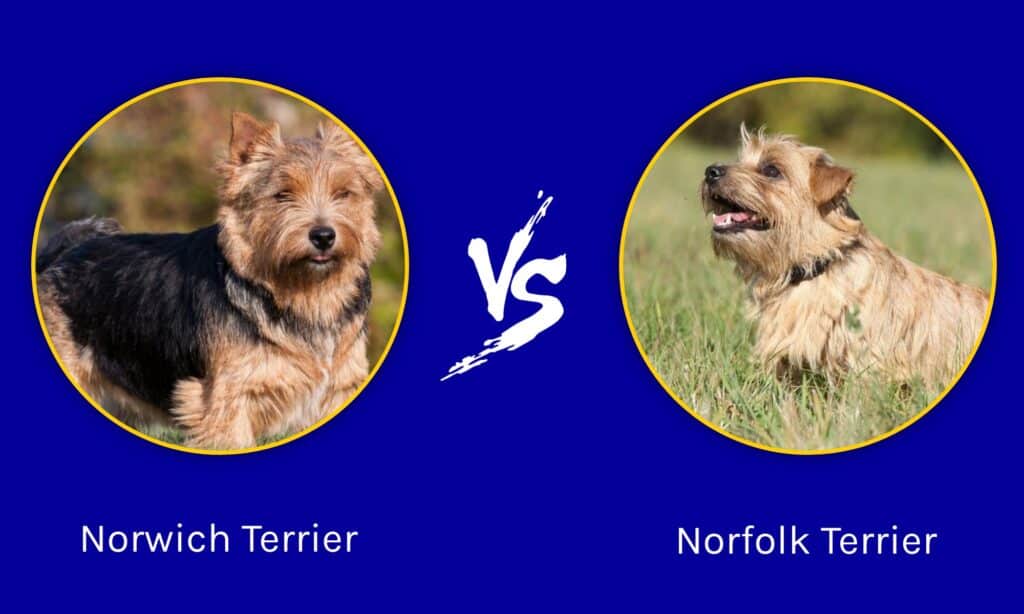
Norwich Terriers are closely related to Norfolk Terriers, so they have a lot in common. For instance, these breeds are the same size. They share the same coat colors including wheaten, black, tan, red, and grizzle. Both breeds require a similar grooming routine. Also, both dogs have about the same lifespan.
There are a few differences between the Norwich Terrier and the Norfolk Terrier. The Norwich Terrier has ears that stand up whereas Norfolk Terriers have ears that lay flat. Another difference is a Norwich Terrier has a combination of wiry and soft hair while a Norfolk Terrier’s coat has a mix of wiry and shaggy hair. Though they are both purebreds, the Norfolk Terrier is better known than the Norwich Terrier. So, breeders tend to charge more for Norfolk Terriers. Of course, adoption is always an option for either of these breeds!
Common Health Issues
Norwich Terriers have some common health issues including patellar luxation. A dog with patellar luxation essentially has a kneecap that has shifted out of place. Limping, hopping, and slow movement are all signs of this condition. The treatment for this issue depends on how severe it is. Some dogs simply need physical therapy while others require surgery. A second health issue common to Norwich Terriers is epilepsy. Epilepsy is a neurological disorder that causes seizures. Epilepsy can usually be managed with medication. Cataracts are another common health issue in older Norwich Terriers. Cloudiness in one or both eyes is a typical sign of cataracts. Surgery is sometimes needed to treat this eye condition. The most common health issues of Norwich Terriers are:
- Patellar luxation
- Epilepsy
- Cataracts
Temperament And Behavior
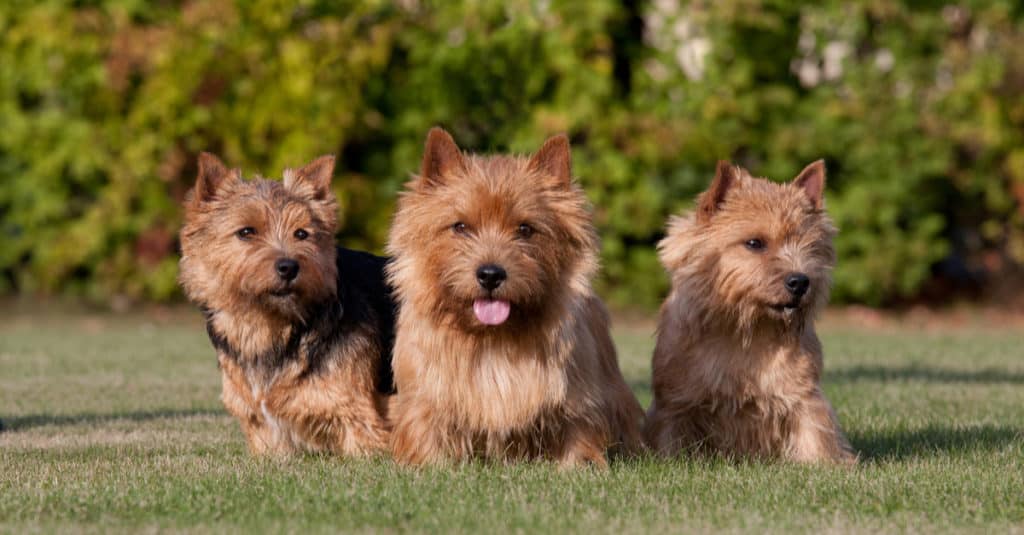
Norwich Terriers loves to dig so an owner may find a collection of holes in the backyard.
©Lenkadan/Shutterstock.com
The temperament of a Norwich Terrier is a mixture of boldness and intelligence. They have a feisty personality and love to chase squirrels, birds, and other animals they see in the backyard! One of their most beloved traits is loyalty. Norwich Terriers like to stay close to their owner!
These little canines are known for their energetic behavior. They were originally bred to find rats and other rodents to chase them from their holes and get rid of them. So, they are fast dogs with excellent digging skills! A family searching for a lively, small dog with a friendly personality is likely to be pleased with a Norwich Terrier.
How To Take Care Of A Norwich Terrier
Learning about the diet, grooming routine, exercise needs, and health issues of a Norwich Terrier puppy or adult dog helps an owner to take the best possible care of this pet. Consider a few specifics regarding the care of a Norwich Terrier.
The Best Dog Food For Norwich Terriers
Norwich Terrier adults and puppies have different diets. Adjusting the diet of a Norwich Terrier as it ages can help to keep this dog in optimal health. Consider some factors in this dog’s diet.
Norwich Terrier puppy food: Protein is a fundamental nutrient in a puppy’s food. Protein supports developing muscles, tendons, and cartilage. Also, it contributes to healthy nails and a thick double coat for this breed. Fat has Omega-3 and Omega-6 fatty acids that support the vision and brain development of a puppy. Healthy eye development is especially important for a breed prone to cataracts. Fat also supplies puppies with energy to play and explore. Vitamin D is good for a puppy’s developing joints. Calcium strengthens bones and teeth.
Norwich Terrier adult dog food: Adults need protein in their diet to keep their muscles and joints strong. These small dogs need a limited amount of fat that supplies them with energy while not adding excess weight. Vitamin C and E are antioxidants that help with healthy cell development. Vitamin A contributes to healthy eyes and can help to fend off cataracts. Calcium contributes to strong teeth and bones in an adult Norwich Terrier.
A-Z Animals finds that the best dog food for Norwich Terriers is Purina Pro Plan Small Breed & Toy Breed Formula Adult Dry Dog Food.
We like how this chicken formula adds glucosamine to your small dog’s diet for protection from conditions like patellar luxation. The levels of calcium supply extra support by nourishing the bones and cartilage, and taurine is great for both the eyes and heart.
Check Chewy or Amazon for this product.
- Shredded Blend Chicken & Rice Formula with probiotics for small dogs
- Fortified with probiotics for digestive and immune health
- Calcium, phosphorus and other minerals maintain strong bones and teeth
- Prebiotic fiber from wheat bran for digestive health
Maintenance And Grooming
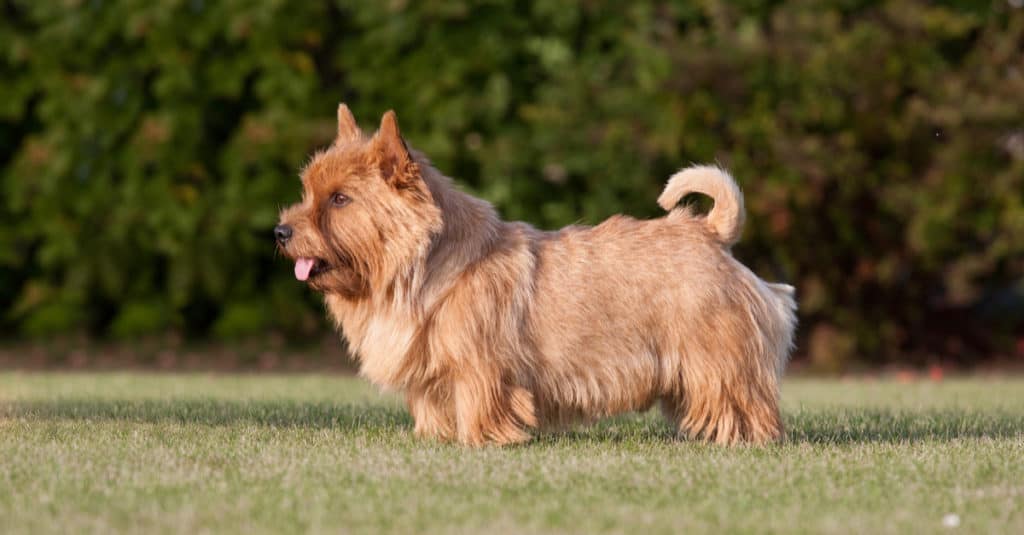
In addition to weekly brushing, a Norwich Terrier’s double coat needs a grooming technique called hand-stripping to keep it looking healthy.
©Lenkadan/Shutterstock.com
How much shedding does a Norwich Terrier do? Though these dogs are considered hypoallergenic, they do end up shedding a small amount of hair. This should be taken into account when breeders advertise hypoallergenic Norwich Terriers.
The grooming routine of these dogs should include weekly brushing. A slicker brush is an excellent tool to help move through the thick double coat of this pooch. Be sure to get a slicker brush with plastic covers on the tips of the bristles. This protects the dog’s skin.
A technique called hand stripping is recommended for these terriers to keep their coat looking healthy.
Redness, bald spots, or dry skin are all signs of eczema in a Norwich Terrier. Grooming the dog once a week can help an owner to become aware of any skin conditions or signs of allergies.
Training

Norwich terriers have a big voice and will let the household know when someone is at the door or on the property.
©Lenkadan/Shutterstock.com
Training a Norwich Terrier is relatively easy. Though they are known as smart dogs, they can be stubborn. So, an owner should limit the training sessions to 15 or 20 minutes and have plenty of treats on hand for successful lessons.
Cairn terriers are also very intelligent but learn best in small doses.
Exercise
These dogs need 30 to 60 minutes of exercise each day. They have a lot of physical and mental energy inside them that needs to be worked out! Taking them on a walk in the neighborhood, playing chase or fetch in a fenced-in yard, or taking them to the dog park are all good options. Norwich Terriers have a strong prey instinct. If they see a bird, chipmunk, or other animals, they are likely to take off after it. Consequently, exercising this dog in an enclosed area or on the leash is a safer choice.
Norwich Terriers are great for people who live in apartments. They fit well into a smaller living environment. As long as they receive exercise, they’re likely to be content in an apartment.
Puppies
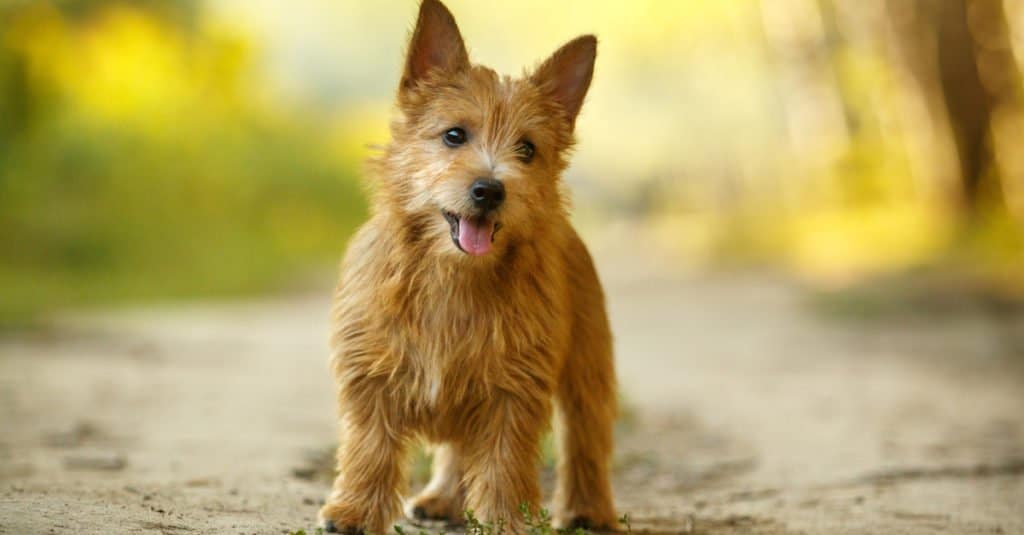
Socialized Norwich Terriers interact well with the children in a family.
©Natalia Fedosova/Shutterstock.com
Like Norwich Terrier adult dogs, puppies need a safe place to exercise so they can explore without wandering into any dangerous situations.
Norwich Terrier And Children
Socialized Norwich Terriers get along well with children. When these dogs are around children from puppyhood, they learn how to interact with them.
Dogs Similar To Norwich Terriers
Dogs similar to Norwich Terriers include Cairn Terriers, Norfolk Terriers and Border Terriers.
- Cairn Terrier: Cairn Terriers can have a black, red, or brindle coat like a Norwich Terrier. They are both loyal and smart dogs. But Cairn terriers weigh a little more than Norwich Terriers.
- Norfolk Terrier: Norfolk Terriers and Norwich Terriers are a lot alike in terms of coat color, weight, and height. One physical difference is the ears of a Norfolk Terrier lay flat while the Norwich Terrier’s ears stand up.
- Border Terrier: A Border Terrier’s coat can be red, tan, black, or wheaten like a Norwich Terrier’s. They are both expert diggers and are loyal to their owners. But the Border Terrier weighs more than a Norwich Terrier.
Popular Names For Norwich Terriers
Some popular names for Norwich Terriers include:
- Cassie
- Pepper
- Ben
- Gus
- Rudy
- Misty
- Sassy
Norwich Terrier FAQs (Frequently Asked Questions)
What is a Norwich Terrier?
A Norwich Terrier is a cousin of the Norfolk Terrier. It’s a small dog bred to find and chase rodents out of their holes. They are smart, feisty dogs known for being loyal to their owner. There are 6 Norwich Terrier mixes.
How much do Norwich Terriers cost to own?
Generally, breeders charge a price of around $1500 for Norwich Terrier puppies. Someone who arranges for a puppy adoption from a rescue organization is going to pay less than they would at a breeder.
The yearly veterinary costs of this dog range from $400 to $600 depending on the services.
The monthly food costs for a Norwich Terrier fall between $50 and $75. The price of the food factors into the final total.
Are Norwich Terriers good with kids?
Yes, socialized Norwich Terriers are good with children.
How long do Norwich Terriers live?
The lifespan of this dog is 13 to 15 years.
How much do Norwich Terriers cost?
The initial price of a Norwich Terrier puppy is around $1500. It’s worthwhile to look into getting a puppy via adoption from a rescue organization. This is a less expensive route and helps support a rescue organization.
Do Norwich Terriers bark a lot?
A socialized Norwich Terrier doesn’t bark excessively.
Can Norwich Terriers be left alone?
Yes, but not for long periods of time. They suffer from separation anxiety if left alone for hours and may begin to destroy household items.
Do Norwich Terriers shed a lot?
No. Though these dogs are sometimes categorized by breeders as hypoallergenic, they do end up shedding a small amount of hair.
What are the differences between Norwich Terriers and Norfolk Terriers?
Norwich Terriers and Norfolk Terriers have different physical appearances in terms of ear carriage, coat texture, exercise needs, yappiness or barking, and costs.
What are the key differences between cairn terriers and Norwich terriers?
The key differences between cairn terriers and Norwich terriers include size, color variations, coat textures, and body proportion.
Thank you for reading! Have some feedback for us? Contact the AZ Animals editorial team.
Sources
- akc.org, Available here: https://www.akc.org/expert-advice/lifestyle/characteristics-of-the-norwich-terrier/
- en.wikipedia.org, Available here: https://en.wikipedia.org/wiki/Norwich_Terrier

